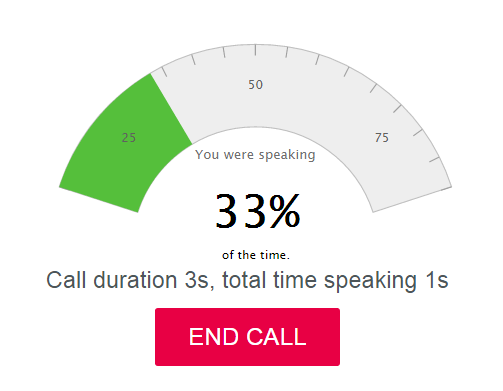Does your mobile phone provide better quality than a typical webcam? I'll test some virtual webcam software for mobile.
Talklessnow.com: A tool to help you listen more
Rethink communications as a tool to help you improve yourself.
Are you listening to me? Probably not. Survey’s have shown that the typical person is only listening about 45% of the time, which consequently means they’re talking 55% of the time. Not listening can also cost you money, Marc Wayshak, Contributor at Entrepreneur Magazine in his research found that poorer performing salespeople tended to talk 81% of the time in a customer’s conversation, whereas over achieving sales stars tended to listen/talk in equal proportions (50/50).
 [ecko_alert color=”grey”]You can learn to listen more with a simple WebRTC tool from talklessnow.com[/ecko_alert]
[ecko_alert color=”grey”]You can learn to listen more with a simple WebRTC tool from talklessnow.com[/ecko_alert]
I’m sitting in a bar with Dean Bubley (author of Disruptive Analysis) and we’re talking about contextual communications and in violent agreement that contextual communications is more than just something a large sophisticated call center might use. Dean believes there are many single user applications to be created. Applications like “TrueCaller” which re-route spam calls are a typical example. Dean though envisioned your Fitbit vibrating if you were talking too much or speaking too fast. This struck me as pure gold.
[ecko_contrast]I want to introduce you to Talklessnow, a free WebRTC browser application which is a training tool to help you listen more (and talk less). You can try it right now at www.talklessnow.com.[/ecko_contrast]
The web application basically turns on your microphone and calculates when you are talking (making noise) and when you listening (quiet) and shows a real time color-coded display of your listen/talk ratio (hint: red is bad). Classic usage, you’re sitting in your office about to make a normal phone call (using your desk or mobile phone), open up the talklessnow.com web page, click the [ecko_button color=”green” size=”small” url=””]CALL[/ecko_button] button as you start your phone call and the application gauge will dynamically update during your call providing you a visual cue as to your listening skills. Hit the [ecko_button color=”red” size=”small” url=””]END CALL[/ecko_button] button when you’re done.
While the application was intended for usage with a traditional phone call. I found it works fine with other WebRTC, VoIP and Skype applications (if you use a headset or earphones so the remote end isn’t coming thru your speaker).
Scary, I’ve been using this tool myself over the past weeks and to my surprise have found this quite helpful. Yes, I talk too much but frankly based up the average 45% listening stat, we all talk too much.
[ecko_pull_quote alignment=”left” source=”Brad Glaser”]Only 2% of us have undertaken any formal listening training in our careers.[/ecko_pull_quote]Listening is an important executive business skill. Since the first article in 1957, the Harvard Business Review has published numerous articles on executive listening. Indeed, HBR annual reader survey’s report an executive’s ability to communicate is a #1 skill. A cursory review by me (basic Google searching about) turned up 35+ survey’s where listening is a key executive attribute.
Listening, though, is hard. Most of us speak at the rate of 125-250 words per minute, unfortunately, we think at 1,000 words per minute, which leaves us way too much think time on how we can interrupt a conversation (or allow our minds to wander off).
Listening is also difficult to remember. Spoken words are processed by our short-term memory and we typically discard about 80% of what we hear! This means you only retain about 20% of what the other person is saying. The math starts to work against you if you’re doing too much talking. For example, if you’re listening at a respectful 50% of the time, you’re really only getting about 10% of the conversation.
But if you’re a bad listener (raise your hand there), say you’re talking 80% of the time, you’re thus only retaining about 4% of what the other person said. And you wonder why you forgot to get the milk your spouse told you to pick up at the grocery store.
[ecko_fullpage_image] [/ecko_fullpage_image]The concept of talklessnow is simple and I hope you will find it helpful to improving your own talk/listen ratio. Of course, being silent and actually listening are two very different matters. Active listening is real work.
[/ecko_fullpage_image]The concept of talklessnow is simple and I hope you will find it helpful to improving your own talk/listen ratio. Of course, being silent and actually listening are two very different matters. Active listening is real work.
As the cost of technology tools near zero, they can easily be embedded to enable a richer communications experience. Are you speaking too fast? Sentiment analysis? Is someone telling the truth? Transcription with contextual links to other information. The chart above is an under the hood glimpse of the web application calculating when you’re talking or listening, you can see this live view at talkless.com/technical.html
[ecko_alert color=”gray”]For now, though, I’m giving you a simple tool.[/ecko_alert]
 While the inspiration of this idea came from Dean Bubley, I couldn’t have implemented this without the great help from the WebRTC development folks at &yet who created the web application and underlying JavaScript that does the calculations (it was harder to figure out when someone is actually speaking than you’d think). Particular thanks to Philipp “fippo” Hancke, who I annoyed, usually in the middle of the night, with classic product manager feature creep requests (hint never tell a developer what you ultimately will get them to build). Finally, thanks to Whit Thiele, an independent developer, who assisted as well in the development.
While the inspiration of this idea came from Dean Bubley, I couldn’t have implemented this without the great help from the WebRTC development folks at &yet who created the web application and underlying JavaScript that does the calculations (it was harder to figure out when someone is actually speaking than you’d think). Particular thanks to Philipp “fippo” Hancke, who I annoyed, usually in the middle of the night, with classic product manager feature creep requests (hint never tell a developer what you ultimately will get them to build). Finally, thanks to Whit Thiele, an independent developer, who assisted as well in the development.